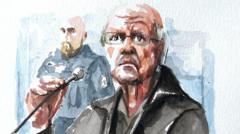Singapore's drug enforcement policies have garnered global attention due to their severity, imposing harsh penalties for drug trafficking while mandating rehabilitation for users. This article examines the experiences of individuals like Kim and Jon, revealing the complexities of Singapore's approach to drug addiction and rehabilitation amid ongoing criticisms and evolving perspectives.
Singapore's Hardline Drug Policies: A Deep Dive into Rehabilitation and Its Consequences

Singapore's Hardline Drug Policies: A Deep Dive into Rehabilitation and Its Consequences
An exploration of Singapore's stringent drug laws, the impact on users and traffickers, and the contrasting approaches to rehabilitation.
In Singapore, drug laws are notoriously stringent, with severe consequences for those caught even with small amounts of narcotics. The story of Kim, a young professional who found herself entangled in drug trafficking charges after helping friends obtain cannabis, exemplifies the risks of the nation’s zero-tolerance approach. Despite the global trend toward decriminalization of cannabis, Singapore maintains laws that presume individuals to be traffickers if they possess certain quantities. As a result, Kim faces potential imprisonment while her friends, classified merely as drug users, have been directed to a state-run Drug Rehabilitation Centre (DRC) for a six-month program designed to prevent reoffending.
The DRC serves as an institution run by the Singapore Prison Service, seemingly akin to incarceration with barbed wire, constant surveillance, and austere living conditions. Inmates undergo psychological education geared towards understanding drug dependence and managing their triggers. Reports highlight that while the aim is rehabilitation, the experience fosters a deterrent regime marked by restrictions and lack of comfort. Educators in these centers, such as Lau Kuan Mei, work to ensure inmates grasp skills that may help them overcome addiction upon release.
In contrast, individuals like Jon, who struggles with methamphetamine addiction, express a mixture of hope and trepidation as they approach the end of their rehabilitation. Many users acknowledge the benefit of learning to manage their drug-related thoughts but remain uncertain about what lies outside the locked environment of the DRC.
Experts suggest that Singapore's approach, historically rooted in criminal justice, is slowly evolving toward a more rehabilitative framework, evidenced by the fact that those who complete their rehabilitation do not gain criminal records. Minister for Home Affairs and Law, K Shanmugam, indicates a shift in mentality towards treating drug users less as criminals and more as individuals in need of support.
Critics, however, assert that the rehabilitation programs may lack depth and fail to confront the underlying causes of addiction, accusing the DRC of fostering a punitive atmosphere rather than providing genuine therapeutic support. The Transformative Justice Collective highlights that the system's structure often leads to humiliation and trauma.
Monitoring continues after release, with the use of electronic tags and urine tests that ensure ongoing sobriety among former inmates. While some successfully reintegrate into society, a significant number find themselves caught in a cycle of addiction and recidivism, raising questions about the effectiveness of Singapore’s strategies in truly addressing drug dependency.
As Kim awaits her fate, the looming potential of imprisonment weighs heavily. With roughly half of the convicted prison population serving time for drug-related offenses, the implications of Singapore's drug policies on personal lives and societal structures remain profound and contentious. Balancing public safety and the welfare of individuals caught in the grips of addiction presents an ongoing challenge for the city-state as it navigates the debate over drug use and rehabilitation.
The DRC serves as an institution run by the Singapore Prison Service, seemingly akin to incarceration with barbed wire, constant surveillance, and austere living conditions. Inmates undergo psychological education geared towards understanding drug dependence and managing their triggers. Reports highlight that while the aim is rehabilitation, the experience fosters a deterrent regime marked by restrictions and lack of comfort. Educators in these centers, such as Lau Kuan Mei, work to ensure inmates grasp skills that may help them overcome addiction upon release.
In contrast, individuals like Jon, who struggles with methamphetamine addiction, express a mixture of hope and trepidation as they approach the end of their rehabilitation. Many users acknowledge the benefit of learning to manage their drug-related thoughts but remain uncertain about what lies outside the locked environment of the DRC.
Experts suggest that Singapore's approach, historically rooted in criminal justice, is slowly evolving toward a more rehabilitative framework, evidenced by the fact that those who complete their rehabilitation do not gain criminal records. Minister for Home Affairs and Law, K Shanmugam, indicates a shift in mentality towards treating drug users less as criminals and more as individuals in need of support.
Critics, however, assert that the rehabilitation programs may lack depth and fail to confront the underlying causes of addiction, accusing the DRC of fostering a punitive atmosphere rather than providing genuine therapeutic support. The Transformative Justice Collective highlights that the system's structure often leads to humiliation and trauma.
Monitoring continues after release, with the use of electronic tags and urine tests that ensure ongoing sobriety among former inmates. While some successfully reintegrate into society, a significant number find themselves caught in a cycle of addiction and recidivism, raising questions about the effectiveness of Singapore’s strategies in truly addressing drug dependency.
As Kim awaits her fate, the looming potential of imprisonment weighs heavily. With roughly half of the convicted prison population serving time for drug-related offenses, the implications of Singapore's drug policies on personal lives and societal structures remain profound and contentious. Balancing public safety and the welfare of individuals caught in the grips of addiction presents an ongoing challenge for the city-state as it navigates the debate over drug use and rehabilitation.




















